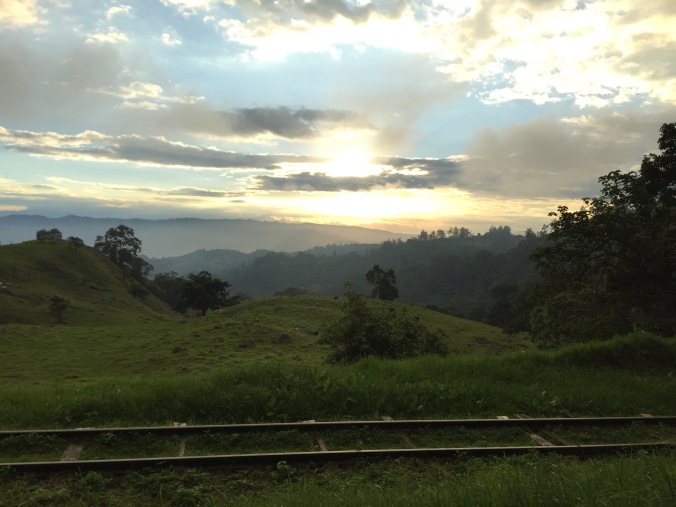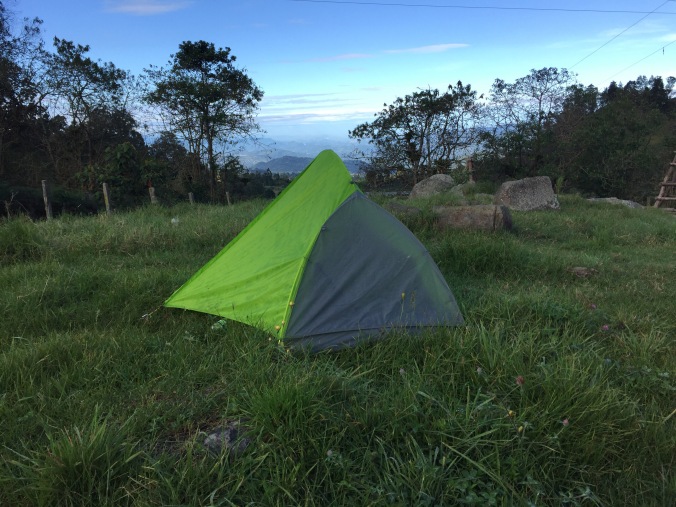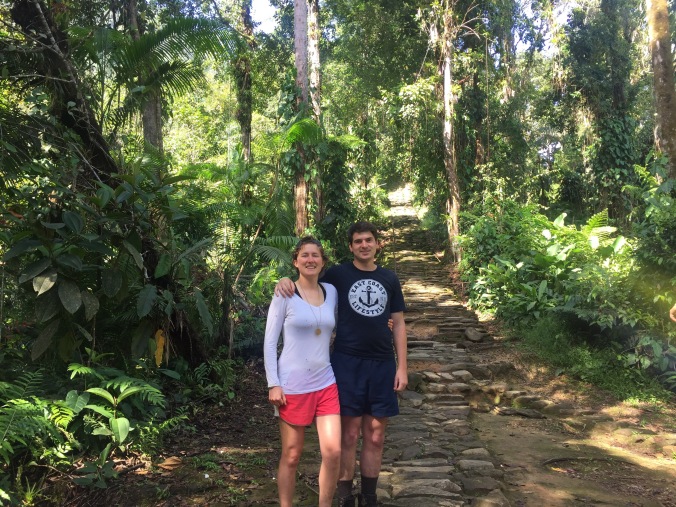For my last days in South America I left the boys to their own devices on the coast and headed back inland to do one final stint as a volunteer. The place I was working is a sustainable community called Monte Samai. It consists of five little cabins, in varying states of completion, spread around a beautiful patch of land in the hills. Five families live there more or less full time, dedicating themselves to off the grid, natural living. They hold workshops in permaculture, carpentry, bioconstruction and sell home made/home grown products and food to make money. The kids are home schooled. Every Friday everyone convenes at the house or herb garden of one of the others, in a rotation, to lend a hand to whatever project needs doing and then they all eat together. It’s all very happy clappy hippie jolly. 
You reach the farm by walking 2km along an abandoned railway from a tiny little village. The tracks weave around the mountain and there were so many butterflies and little colourful caterpillars. It is an excellent approach, accompanied by the sound of rivers rushing over rocks.

The volunteers spend a few days with a family at a time, eating meals with them and working in the morning on whatever needs doing. The first few days I was with Adrian and Carolina and their cute five year old daughter, Mimbi. We did some hardcore weeding of the little corn field. You could barely see the little corn stalks through the wilderness of weeds and it was very satisfying to rip the roots out and hack away with a machete.
It got quite awkward at one point when Carolina was washing clothes in a sink and I asked her if she missed a washing machine and she started crying and saying how much she missed her mother and family and having a proper house and electricity… turns out the whole rural life is Adrian’s idea and although she would be into it, he never consults her about anything and takes all the decisions himself (following Colombian machismo culture, very different from the much more gender equal culture of Argentina where she’s from) and she feels like a prisoner. She said her grandmothers used to be peasant farmers back in Argentina and she feels that she’s become that way now, enslaved. But she wants to be with Mimbi, Mimbi is very happy in the countryside, and wants to be with her dad too. It was terrible! I didn’t know how to comfort her, especially because we were speaking in Spanish. It was a good lesson that not all hippies live in paradise.
I was in paradise though. The manual labour really agreed with me. Later on in the week I was digging foundations for the house of another guy, Hafid, and I could have gone on pickaxing and shovelling all day. I think I was a miner in a past life, but not one of the ones who went dolefully in and died shortly after of lung disease. A more fulfilled one.
They have all sorts of spiritual ceremonies and are very into appreciating mother earth and being grateful and loving and all that, and you could really feel it. All the time I was there I felt that they really cared about me, and that I was special and interesting (even though I was mainly speaking Spanish and I am a crippling bore in Spanish), but also that no matter what kind of lazy imbecile would have come, they would have received the same treatment. I have a tendency to be more exclusive in my approbation and acceptance so was quite inspired by their way of being.
On full moon we had a women’s circle, which involved building a fire and playing the guitar and singing and chanting for a couple of hours and then smoking a sacred tobacco thing (not a cigarette, thank you, some sort of fatter contraption) and then everyone went round and talked about their feelings. It wasn’t at all the way I’d spend a night usually but everyone ended the night in a kind of ecstasy so I recommend it if anyone’s looking for a bonding activity.
Another day we all, men and women combined, gathered to read tarot cards, do a “five rhythm dance”, which is dancing to five songs, the first with flow and fluidity, then structure building/robotic, then chaotic to break down the structures, then creative, then calm, and then give massages to each other. So interesting seeing how unselfconscious everyone was during all of these activities.

Another quite bizarre ritual I got to witness was a woman burying her placenta and planting a tree on top of it. At first I was utterly repulsed because the placenta looked like dead guts in a bowl and I didn’t know why we would be going through this, but then we all threw handfuls of dirt into the hole on top of it and said all of the material and spiritual things we hoped for the baby and there was more guitar playing and more incense and flowers laid around the tree and the baby looked cute and happy and it was actually a very nice ceremony.
On my last day Hafid and I went into the village early in the morning to buy provisions and while we got a coffee he suggested that we go to the larger town because I said I needed to go to a cash point and he fancied stopping in on a friend. So off we popped (in a shared taxi thing that was full, but still stopped so that a woman and her daughter could squeeze into the passenger seat along with the random man who was already sitting there) and strolled into this hippie house belonging to a woman called Girasol (Sunflower) just out of the town. It turned out that it was the 50th birthday of Girasol’s friend, Gary, who was from London, and he was over the moon that someone from London had come to visit him on his birthday. They showed me around the place, Gary was building a bamboo house in the garden, and they had a special long room divided into seven by coloured curtains overlooking the valley where they meditated every day on a different day. It was all very spontaneous and slow moving and chilled and friendly and fun.

Now I’m at Orlando airport on my layover, in between rounds of a bird board game with a cute family from Maine who are my new friends. Sad to leave South America but happy that I’ll be returning in January.









